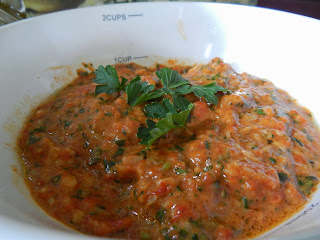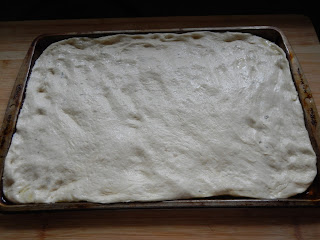It is said in the Arab world when a piece of bread falls on the ground it is quickly picked up and kissed and raised to heaven. Bread to many cultures is not only a staple but sacrosanct. I love bread, I can think of no better vehicle to sop up sauces and encase delicious fillings of meat, cheese etc.
We however live in a world where bread is vilified. Everything ranging from added "empty" calories, gluten allergies and high carbohydrate servings are the driving factors behind transforming something holy to a behemoth. I am sorry but I refuse to believe that a food which humanity has indulged in for centuries is evil. There were times in our progress as humans that all we survived on was bread. It has seen us through wars and continues to comfort and nurture us till today. Every culture has it's own form of bread - bread is not just food, it is history. Should we throw away history because of a passing fad? I think not.
That being said, I believe bread should be eaten how it was for centuries. In other words, not from a factory which has mass produced it and pumped it full of preservatives and additives. We need to get back to eating REAL food, and bread is on that list. We need to get back to kneading our own dough, watching it prove and enjoying the reward right out of the oven. I guarantee you, very few things are better than hot fresh bread right out of the oven. Served with it's eternal partner butter is nothing less than ambrosia. If you have never had the courage to try baking your own bread I implore you, have faith and all will be well. It's not as daunting as you may think and the process will actually be quite rewarding, therapeutic even!
So for my recipe I have chosen a dough I make very week. I purchased Paul Hollywood's book "How to Bake" and have made many breads since and have been nothing short of pleasantly pleased with the results. Now bear in mind this isn't the ciabatta from the corner artisan bakery. It is made in a relatively short time - 3 to 4 hours total so you won't end up with a crumb structure with the holes and extra chewiness that an artisan ciabatta bread produces but you will end up with an extremely moist, crusty bread which will never get hard on you. You will be eating this bread for breakfast for days and I promise you won't break your jaw in the process. This is my main stay recipe for ciabatta and I urge you to try it. Further more, I urge you to purchase the book you will have no regrets.
Now there are a few pointers before you embark on this ciabatta journey. The dough is made with cool water which means the proving time will be slower. This only aids flavour so be patient. The dough is extremely wet so don't even think of kneading it. I make my own using my kitchen aid but it can be done using a bowl and wooden spoon. I also never use all the water called for in the recipe. Hollywood states that you should start by adding 3/4 of the water than adding more as you go along but I almost always just use 3/4 of it alone. So add the water slowly. Don't be scared when you see the dough looking more like paste than dough - that's how it is meant to look and please don't over handle it. It needs minimal handling. So these are my pointers and hopefully you will be on your way to making your own fresh bread. Good luck!
Ciabatta (adapted from Paul Hollywood's book "How To Bake")
500g strong white bread flour, plus extra for dusting
10g salt
10g instant yeast
40ml olive oil
400ml tepid water
Fine semolina for dusting (optional)
1. Lightly oil a 2-3 litre square plastic container. (It's important to use a square tub as it helps shape the dough.)
2. Put the flour, salt and yeast into the bowl of a mixer fitted with dough hook (I use the paddle attachment as I have found it mixes the dough better) Don't put the salt directly on top of the yeast. Add the olive oil and three-quarters of the water and begin mixing on a slow speed. As the dough starts to come together, slowly add the remaining water. Then mix a further 5 - 8 minutes on a medium speed until the dough is smooth and stretchy.
3. Tip the dough into the prepared tub, cover with a tea towel and leave until at least doubled, even trebled in size 1-2 hours or longer. The longer proving time means more flavour.
4. Heat your oven to 220 celcius and line a baking tray with parchment paper.
5. Dust your work surface heavily with flour - add some semolina too, if you have some. Carefully tip out the dough (it will be very wet) onto the work surface, trying to retain a rough square shape. Rather than knocking it back, handle it gently so you keep as much air in the dough as possible. Coat the top of the dough with more flour and/or semolina. Shape the dough into one long shape or two medium loaves. Stretch each piece of dough lengthways a little and place on prepared tray.
6. Leave the ciabatta dough to rest for a further 10 minutes, then bake for 25 minutes, or until the loaf or loaves sound hollow when tapped on the base and are golden. Cool on a wire rack.
The very wet dough. As you can see it would only be possible to mix in a stand mixer or with a wooden spoon.
The dough after it was shaped and proved for 3 hours. I then left it to prove for another twenty minutes given that my loaf was so large.
The final product...hot out of the oven.
The crumb structure was not the distinctive "holey" structure of ciabatta due to the short proving time. However the bread was very tasty and made it relative ease. The crumb structure was very tender and was gobbled with lashings of butter.





















